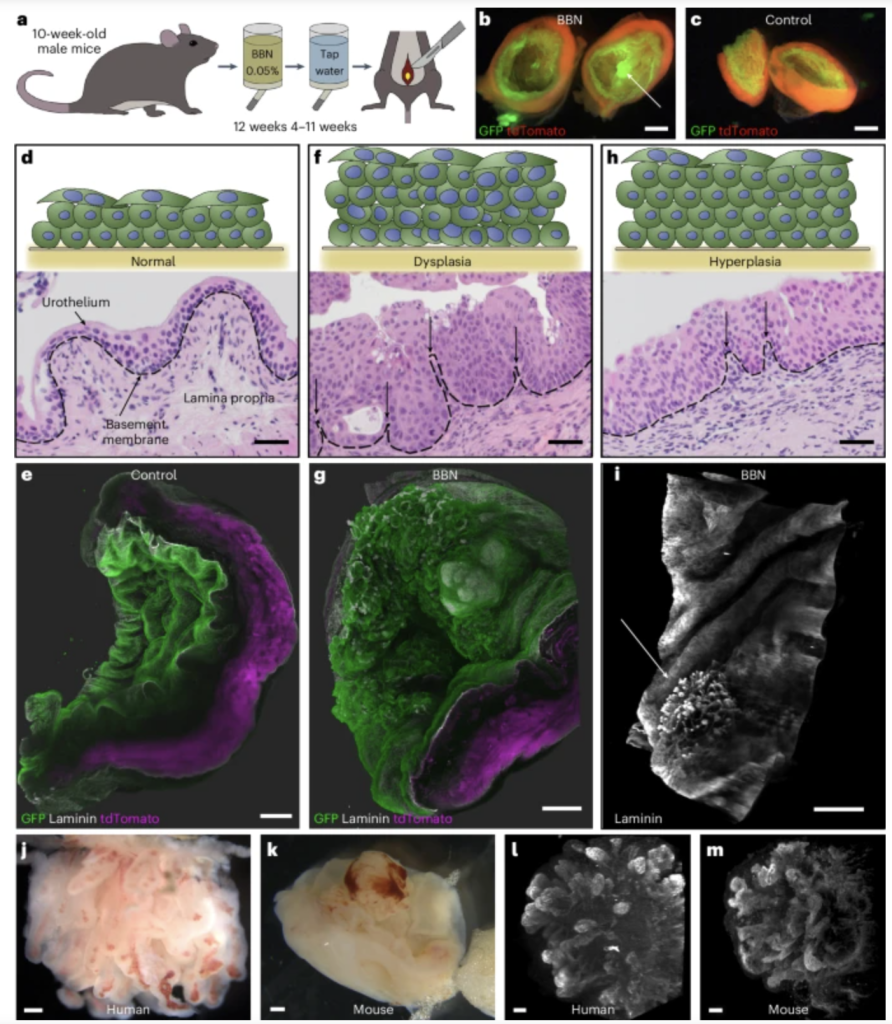by Kaykobad Hossain
Carcinomas are the most prevalent form of cancer, which is characterized by malignancies of epithelial tissues. Bladder cancer, one of the costliest cancers to treat, is ideal to investigate epithelial morphogenesis at early stages of tumorigenesis due to availability and accessibility of tissue samples to be monitored at different stages. Alterations of tumor extracellular matrix influence cancer progression and therapy response and carcinomas need to breach the basement layer to become invasive and eventual metastasis. Research have shown that mechanical forces can also contribute to invasion and require more studies.
In this paper, the researchers used N-butyl-N-(4-hydroxybutyl) nitrosamine (BBN, a bladder specific carcinogen) mouse model and integrated continuum mechanics, 3D microscopy and atomic force microscopy to identify the connection between early changes in basement membrane morphologies and mechanical buckling that is fueled by urothelial overgrowth and alterations in tissue stiffness.
After 11 weeks of BBN treatment, the histopathological sections showed emergence of different types of urothelial neoplasms, which include dysplasia, carcinoma in-situ and papillary tumors. In addition, after only 4 weeks of BBN treatment, urothelial cells with hyperplasia and the basement membrane with localized fine-grained buckling pattern are observed. Moreover, similar basal membrane morphology was found in the human bladder tissue biopsies from non-muscle invasive (pTa) tumor with comparable shape and size as mice bladders.
The morphometric analyses showed that the control mouse bladders have relatively uniform urothelial thickness profile with normal folding pattern for an empty bladder. 4 weeks BBN treated mice, on the other hand, have bladders with thicker urothelium with various degrees, with the basement membrane either remaining smooth or visibly roughening. However, both within and between bladders of BBN treated mice, a greater variation in urothelial thickness was observed compared to the controls. Bladders from the BBN treated group also present cell shape differences, such as elongated or enlarged cells, along with partial or complete loss of umbrella cells. However, samples that have papillary-like structures do not show the similar changes.
The researchers also developed a computational model to simulate the continuum mechanics of planar 3D sections of the bladder mucosa and showed that the mechanical simulations recapitulate different membrane basement morphologies that are seen in mice and human samples. In addition, they also showed that both stiffening of the lamina propria and softening of the urothelium, and basement membrane are necessary for the lesion formation.
Continue your reading here:
Franziska L. Lampart, Roman Vetter, Kevin A. Yamauchi, Yifan Wang, Steve Runser, Nico Strohmeyer, Florian Meer, Marie-Didiée Hussherr, Gieri Camenisch, Hans-Helge Seifert, Cyrill A. Rentsch, Clémentine Le Magnen, Daniel J. Müller, Lukas Bubendorf & Dagmar Iber Morphometry and mechanical instability at the onset of epithelial bladder cancer Nature Physics volume 21, pages 279–288 (2025)

